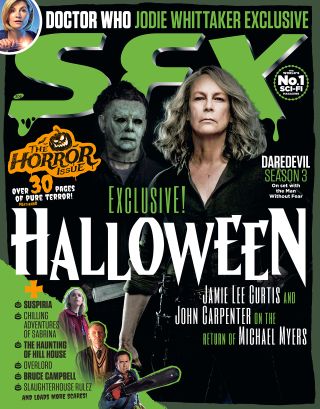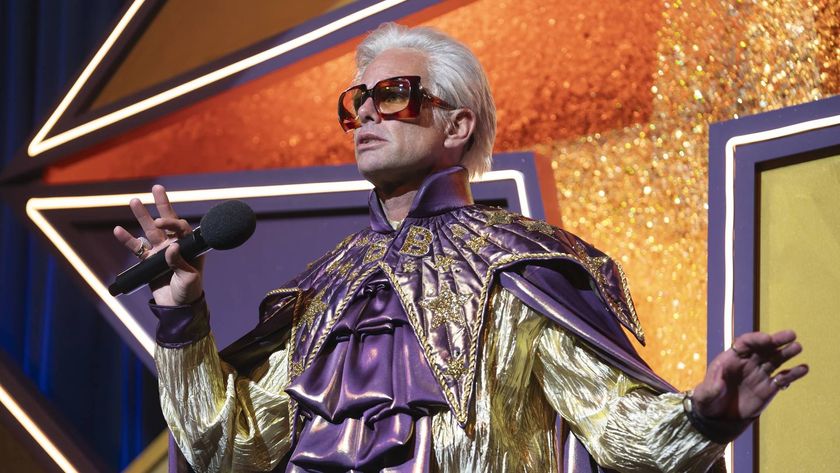The Haunting of Hill House showrunner on turning the classic ghost story into a Netflix Original
Shirley Jackson's tale of a "vile, diseased" mansion, is coming to the small screen. Showrunner Mike Flanagan reveals all

Architecture whose every angle is askew. A labyrinthine layout, with rooms arranged in concentric circles. A vertiginous spiral staircase, leading to a balcony from which a woman once launched herself into space, her neck in a noose. Who lives in a house like this? No one with any good sense...
Shirley Jackson’s 1959 novel The Haunting of Hill House – and The Haunting, the classic 1963 film which adapted it – unfolds in one of horror’s least desirable residences. Now it’s welcomed new tenants for a 10-part Netflix TV series. It’s a dream gig for showrunner/director Mike Flanagan (Oculus, Ouija: Origin of Evil), who read the book at a tender age.
“It had a real impact on me,” Flanagan tells our sister publication SFX magazine. “The characters are so beautifully drawn. I also saw the Robert Wise film when I was very young – it absolutely terrified me! As I got older and grew to appreciate the film’s artistry, what struck me was how it managed to frighten people by showing them absolutely nothing. Wise did more with sound effects and a close-up of a door than most horror movies accomplish with millions of dollars of computer-generated effects!”
Shirley Valentine

In both Jackson’s book and Wise’s film, a paranormal researcher rents Hill House and invites three guests to this “place of contained ill will”: the highly-strung Eleanor Vance (Nell for short), who experienced poltergeist activity as a child; Theodora, a vivacious lesbian with ESP ability; Luke Sanderson, the property’s disreputable future heir. Soon they’re encountering a mysterious “cold spot”, being woken by furious banging, and finding sinister messages scrawled on the walls.
“I’ve always considered that film to be perfect, and have revisited it many times,” Flanagan says. “So when Amblin Partners said they were interested in expanding it into a season-long TV property, my first reaction was, ‘Well, how?’ The material fits so comfortably into a feature film format, and Bob Wise had already done it perfectly.”
His solution: keeping key elements but “running it through a different prism” by throwing out the key cast and assigning their names to different characters. So Nell, Theo and Luke are now three of five siblings in the fractured Crain family; Shirley (after Jackson) and Steven (a nod to The Haunting fan Spielberg?) are the other two. The series jumps back and forth between events they experienced two decades ago at Hill House and their present-day lives in occupations like child psychologist, mortician and novelist.

“I’m very drawn to family horror,” Flanagan explains, “So we came up with a new structure that was about a family that’d moved into the house. Then the idea was that we’d spend the first half of the season focusing on one sibling each episode, and the second half would be about bringing the family back together and getting back to Hill House.”
Sign up to the SFX Newsletter
Get sneak previews, exclusive competitions and details of special events each month!
Typically horror ends with a traumatic event, and we only see how it affects the characters’ lives if it’s explored in a sequel. Here the way trauma echoes down through the years is threaded throughout.
“It’s a theme that’s really fascinating to me,” Flanagan says. “How the trauma of our youth can shape our adulthood. This was always a show about family, grief and trauma. It just happened to be wrapped in the skin of a horror. We talked about things like Six Feet Under – authentic family dramas. To me, it’s more interesting to be in that world and let the horror elements creep into that space than it is to just go for the jolt.”

Robert Wise would surely have agreed, as his film is renowned for its subtle scares. There are no spectral visitations or geysers of blood – just eerie noises and a door warping out of shape. Flanagan was keen to pay homage.
“We have our riff on a famous sequence he did with Eleanor and Theo huddled in a bed, while you’re hearing these phantom banging noises. We went down to the basic shot sequence and mirrored him almost exactly.” But he also knows that a modern audience expects to see more. So expect to encounter spirits in Hill House – like the creepy “Bent Neck Lady”.
“It was clear early on that we could never go the full Wise,” Flanagan admits. “When it came to having to show ghosts, I knew we couldn’t get away with not doing it. The thing I wanted to take from Wise, though – and from the novel – is the idea that you may not understand what you’re seeing, and playing with the audience’s assumptions. So there are twists coming that will recontextualise a lot of the ghosts. We wanted to be true to the ambiguity Jackson played with so beautifully about whether or not the house was even haunted as well. So while we’re more explicit, that doesn’t always mean you can trust what you see.”
Sick building

Flanagan also drew heavily from the novel when it came to the crucial matter of depicting Hill House – which we see as both a family home and in a dilapidated state. “We needed it to feel schizophrenic,” Flanagan says. “That so many people had lived and died in it, and so many different people had hands in building it over the years.” They stumbled upon the house used for exteriors out in the woods in Georgia.
“It’s one of the strangest buildings I’ve ever seen,” Flanagan laughs. “You look at it from one angle and it looks Victorian, very angular and clean. From another angle it looks medieval – it has these stone turrets that don’t make any sense! Once we found it, it really inspired the production designer for our interior build.”
Some of the ways his set works its effects on the viewer are practically subliminal. “We wanted the house to be full of implied or explicit faces that were always staring at the characters – or the audience,” Flanagan reveals. “Almost all our wallpaper has different facial patterns inside it. They’re in the doorknobs too – some are animals, some human. Then there’s the placement of windows in relation to fireplaces: we laid out eyes and an open mouth in all the rooms. It’s a subconscious thing, but it creates this sense of unease.”

That’s not the only thing to look out for. There are references aplenty – some more obvious than others. “When you get to episode 5 you’ll see Russ Tamblyn, who played Luke in the Robert Wise film,” Flanagan reveals. “He plays a character called Dr Montague. One of my favourite parts of production was giving him a tour of Hill House – that was absolutely surreal! We went through the novel finding story points, character moments, and sometimes specific language, and finding ways to pepper them through the series. I wanted the film to be an irreverent tribute to the book, and to Robert Wise.”
Other nods are more discreet. Take the stone lions. In Jackson’s book, Eleanor is fascinated by a house which has a pair sitting outside, and talks of having some on her mantelpiece. “We had our own stone lions placed carefully around the house,” Flanagan says. “But also there’s a hotel the characters stay in: the Stone Lion Inn. Little Easter eggs like that were delightful for us. I hope the fans can grab onto them.”

It’s been Flanagan’s first experience of working in this medium, but it sounds like it won’t be his last. “I’ve wanted to get into television for a long time,” Flanagan says, “because of how much larger the canvas is – how much time you can spend with the characters, and how thorough you can be with their arc.” But next time Flanagan may think twice before choosing to direct every episode of a series himself...
“I approached it like a 10-hour movie, and it really felt that way. By day 50 of our shoot, knowing that we’d not yet reached the halfway mark, that was somewhat overwhelming. I’m working on a movie now and it seems incredibly relaxing. It’s like, ‘We only have to do two hours – that’s nothing!’ It feels like a long vacation!”
The Haunting of Hill House begins streaming on Netflix on October 12, 2018.
This feature originally appeared in our sister publication SFX magazine. For more about The Haunting of Hill House and other sci-fi and fantasy features, interviews, reviews, and more, pick up a copy now or subscribe so you never miss an issue.

Ian Berriman has been working for SFX – the world's leading sci-fi, fantasy and horror magazine – since March 2002. He's also a regular writer for Electronic Sound. Other publications he's contributed to include Total Film, When Saturday Comes, Retro Pop, Horrorville, and What DVD. A life-long Doctor Who fan, he's also a supporter of Hull City, and live-tweets along to BBC Four's Top Of The Pops repeats from his @TOTPFacts account.

















